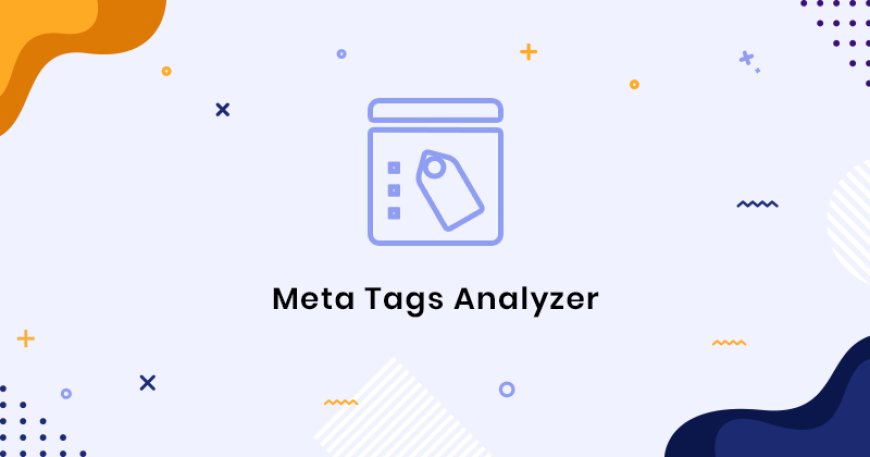Understanding Meta Tags: A Comprehensive Analysis
This article will delve into the importance of meta tags, their various types, best practices for usage, and how to analyze them effectively to enhance your website’s performance.

What are Meta Tags?
Meta tags are snippets of text that provide information about a webpage’s content. They are not visible on the page itself but reside in the HTML code of the document. Meta tags serve various purposes, including improving SEO, enhancing social media sharing, and informing browsers and search engines about a webpage’s specifics.
Types of Meta Tags
-
Meta Title Tag: Also known as the title element, this tag defines the title of a webpage and appears as the clickable link in search engine results. It should be concise, ideally between 50-60 characters, and include relevant keywords.
-
Meta Description Tag: This tag offers a brief summary of the page’s content, typically around 150-160 characters. While it doesn’t directly influence SEO rankings, a compelling meta description can improve click-through rates (CTR).
-
Meta Robots Tag: This tag instructs search engine crawlers on how to index a webpage. For example, using
noindexprevents a page from appearing in search results, whilenofollowtells crawlers not to follow links on that page. -
Meta Keywords Tag: Once widely used, this tag is now largely deprecated due to abuse and keyword stuffing. Most search engines, including Google, do not consider it for rankings.
-
Open Graph Tags: Used primarily for social media sharing, Open Graph tags help control how a webpage appears on platforms like Facebook. They allow you to specify titles, descriptions, and images to be used when the content is shared.
-
Twitter Cards: Similar to Open Graph, Twitter Cards are used to enhance how your content is displayed on Twitter. They enable you to attach rich photos, videos, and media experiences to Tweets.
Why Are Meta Tags Important?
1. SEO Optimization
Meta tags play a crucial role in SEO. The meta title and description are often the first impression users get from search engine results. A well-optimized title and description can significantly affect a website's visibility and CTR. Including relevant keywords helps search engines understand the content and context of your page, which can improve ranking.
2. User Engagement
The meta description serves as a pitch to entice users to click through to your site. A clear, engaging description that accurately reflects the page’s content can draw more visitors. If users find your content appealing, they are more likely to engage with it, thereby reducing bounce rates and improving rankings.
3. Social Media Sharing
With the rise of social media, the way your content is presented on these platforms can greatly influence traffic. Open Graph and Twitter Card tags ensure that when users share your content, it looks professional and compelling, encouraging others to click on it.
4. Control Over Indexing
Meta robots tags give you control over how your pages are indexed by search engines. This is particularly useful for pages that should not appear in search results, such as thank-you pages or duplicate content.
Best Practices for Using Meta Tags
1. Crafting Effective Title Tags
- Include Keywords: Use relevant keywords at the beginning of the title.
- Be Concise: Keep it under 60 characters to ensure it displays correctly in search results.
- Branding: Consider including your brand name to build recognition.
2. Writing Compelling Meta Descriptions
- Summarize Accurately: Provide a clear, accurate summary of the page’s content.
- Incorporate Keywords: Include primary keywords to enhance relevance.
- Call to Action: Encourage clicks with actionable language, such as “Learn more” or “Get started today.”
3. Utilizing Open Graph and Twitter Cards
- Optimize for Each Platform: Customize tags for different platforms to improve sharing performance.
- Choose Eye-Catching Images: Use high-quality images that represent your content well.
4. Implementing Robots Tags Wisely
- Identify Important Pages: Use
noindexfor pages you don’t want indexed, such as admin pages or duplicate content. - Test Your Settings: Regularly check that your robots settings align with your indexing goals.
Analyzing Meta Tags
To ensure your meta tags are effectively enhancing your site’s performance, regular analysis is essential. Here are some strategies to evaluate and optimize your meta tags:
1. Use SEO Tools
Various SEO tools can help analyze your meta tags. Tools like Moz, SEMrush, and Ahrefs provide insights into how well your titles and descriptions perform and whether they contain relevant keywords.
2. Monitor Click-Through Rates
Using Google Search Console, you can monitor the CTR for your pages. A low CTR may indicate that your meta descriptions aren’t engaging enough or that they don’t accurately reflect the content.
3. A/B Testing
Experiment with different title tags and descriptions to see which variations perform better. A/B testing can provide valuable insights into what resonates with your audience.
4. Regular Audits
Conduct regular audits of your site’s meta tags. Over time, content and user preferences can change, so staying updated ensures your tags remain relevant and effective.
Conclusion
Meta tags are a vital yet often overlooked element of web development and SEO. They provide essential information to search engines and users, impacting everything from visibility to user engagement. By understanding the different types of meta tags, adhering to best practices, and conducting regular analysis, you can significantly enhance your website's performance. As the digital landscape continues to evolve, keeping a keen eye on your meta tags will ensure you stay ahead of the curve and maximize your online presence.

 jamesbernardo
jamesbernardo